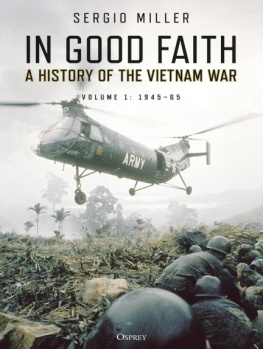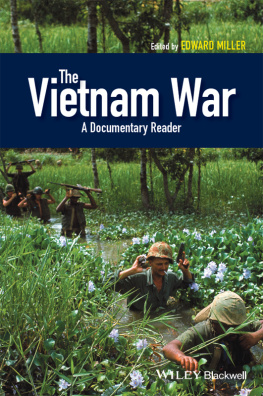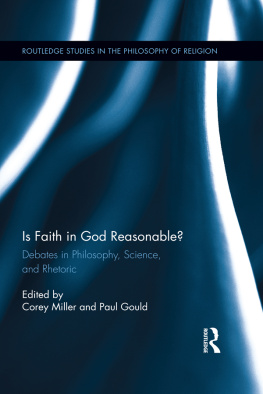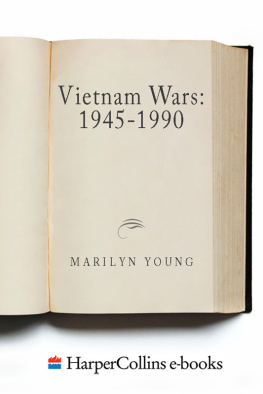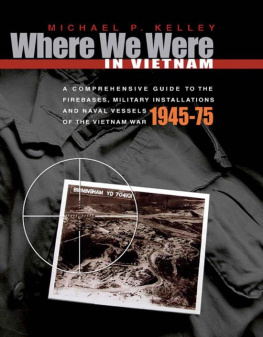Sergio Miller - In good faith : a history of the Vietnam War. Volume 1, 1945-65
Here you can read online Sergio Miller - In good faith : a history of the Vietnam War. Volume 1, 1945-65 full text of the book (entire story) in english for free. Download pdf and epub, get meaning, cover and reviews about this ebook. year: 2021, publisher: Bloomsbury Publishing, genre: History. Description of the work, (preface) as well as reviews are available. Best literature library LitArk.com created for fans of good reading and offers a wide selection of genres:
Romance novel
Science fiction
Adventure
Detective
Science
History
Home and family
Prose
Art
Politics
Computer
Non-fiction
Religion
Business
Children
Humor
Choose a favorite category and find really read worthwhile books. Enjoy immersion in the world of imagination, feel the emotions of the characters or learn something new for yourself, make an fascinating discovery.
- Book:In good faith : a history of the Vietnam War. Volume 1, 1945-65
- Author:
- Publisher:Bloomsbury Publishing
- Genre:
- Year:2021
- Rating:5 / 5
- Favourites:Add to favourites
- Your mark:
- 100
- 1
- 2
- 3
- 4
- 5
In good faith : a history of the Vietnam War. Volume 1, 1945-65: summary, description and annotation
We offer to read an annotation, description, summary or preface (depends on what the author of the book "In good faith : a history of the Vietnam War. Volume 1, 1945-65" wrote himself). If you haven't found the necessary information about the book — write in the comments, we will try to find it.
Sergio Miller: author's other books
Who wrote In good faith : a history of the Vietnam War. Volume 1, 1945-65? Find out the surname, the name of the author of the book and a list of all author's works by series.
In good faith : a history of the Vietnam War. Volume 1, 1945-65 — read online for free the complete book (whole text) full work
Below is the text of the book, divided by pages. System saving the place of the last page read, allows you to conveniently read the book "In good faith : a history of the Vietnam War. Volume 1, 1945-65" online for free, without having to search again every time where you left off. Put a bookmark, and you can go to the page where you finished reading at any time.
Font size:
Interval:
Bookmark:

DEDICATION
To a good school friend
Frank de Planta
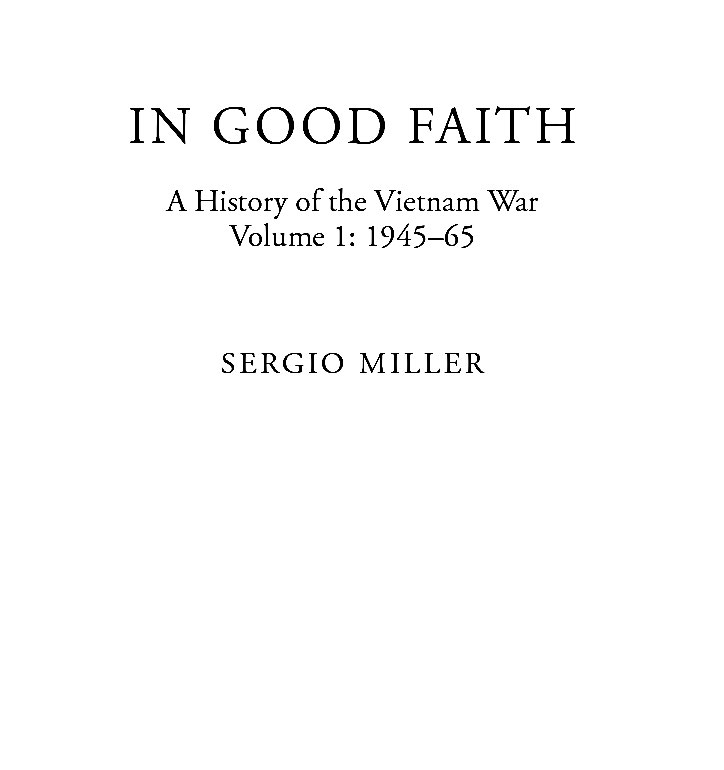
| Map 1 | French Indochina Before 1945 |
| Map 2 | Viet Minh Held and Contested Areas, November 3, 1950 |
| Map 3 | The 1954 Division of Vietnam Along the 17th Parallel |
| Map 4 | Viet Cong Dominated and Contested Areas, Spring 1961 |
| Map 5 | The Battle of Ap Bac, January 2, 1963 |
| Map 6 | Gulf of Tonkin Incident, August 2, 1964 |
| Map 7 | Rolling Thunder Targets for MarchApril 1965 |
Yoshijiro Umezu, Chief of the Army General Staff, bowed very low, as well he might. Three weeks previously his country had twice been visited by a divine, destructive wind beyond the imagination of man. It blew in from the east and was released from the bellies of two silver aircraft flying high above the clouds, barely visible except to an attentive observer. Imperial Japan had vowed that the flower of her youth would stop the relentless advance of the American foe. Even on the verge of defeat and faced with the imminent invasion of the home islands, the Imperial Japanese Headquarters plotted insane, fantastic attacks involving 6,500 kamikaze pilots and 5,000 suicide boats to halt the invaders. If it came to it, the generals concluded, 100 million Japanese should sacrifice their lives and charge the enemy with swords and bayonets.
America gave her answer with the thunderclap of two atomic bombs. Metro-Goldwyn-Mayer celebrated this novel way of annihilating entire populations by publishing a full page advertisement of a bikini-clad model called Blanca Welter Miss Anatomic Bomb enjoying solar energy in an unexplosive moment, possibly the most vulgar documented response to the sudden, violent deaths of 150,000 human beings. Faced with annihilation, Emperor Hirohito made his jeweled voice capitulation speech to the nation, in fact a broadcast of a barely intelligible pre-recorded statement spoken in archaic Japanese. The previous day, Japan had been attacked by the biggest air raid of the Pacific War involving over 1,000 aircraft dropping conventional but no less destructive bombs. An earlier mass leaflet drop revealing the Emperors secret decision to surrender had raised fears of civil unrest. This last psychological operation, coupled with the unstoppable Soviet advance through Manchuria, sealed the capitulation. Later detractors of the use of atomic weapons would ignore that, even in the very last hours of the war, Japan had to be pummeled into surrendering. The biggest shock of the atomic bomb was just how un-shocked contemporaries were by its use.
An 11-strong Japanese surrender delegation boarded the USS Missouri anchored in Tokyo Bay on September 2, 1945. They were led by the bespectacled Foreign Minister, Mamoru Shigemitsu, dressed incongruously in tails, white gloves, and a top hat. His left hand gripped a walking stick, a curiously emaciated symbol of state propping his missing leg. General Umezu, with downturned mouth, wore his customary peaked cap, three rows of medals, and riding boots with spurs. He looked, like the rest of the party, drawn and beaten.
The surrender ceremony lasted less than half an hour, watched in silence by the entire ships company and 300 journalists and photographers. MacArthur led the proceedings but Fleet Admiral Nimitz made sure his name was also on the instrument of surrender (with the distinction that he was signing on behalf of the American nation, whereas MacArthur was signing in his capacity as Supreme Commander Allied Forces). Immediately behind the table on which the surrender documents would be signed, in single rank, were representatives of all the other countries with a stake in the brief and now vanquished Japanese empire: the old colonial powers, Britain, France, and the Netherlands, as well as the awakened giants, China and the Soviet Union. Under the terms of the surrender, only four of the eight nations ranged against Japan were legally counted as an Allied Power; the remainder were parties to the surrender. The French representative found himself relegated to the second rank of powers, along with minnows like New Zealand.
Following the short ceremony there could be no doubt that the emperor god had been brought back down to earth, and a new deity resided on the summit of Mount Fuji. America now found herself the de jure ruler of an Asian country, her western border stretched across five thousand miles of ocean and now lying on the rim of the most populous continent in the world. Five years later and using a football metaphor, Secretary of State Dean Acheson would call this Americas new defense line against a fresh enemy communism. The line snaked all the way from northern Japan to the southernmost islands of the Philippines, bypassing Korea with unintended consequences, and stopping short of the remaining European colonies of Southeast Asia, including French Indochina. Like great military irruptions of the past it left the conquerors both bewildered and fascinated by their new possessions. This was the first important consequence of the war in the Pacific.

For the next four decades, facing down the Soviet Union became the monolithic, unifying theme of American foreign policy, and its abiding metaphor was the race: in the development of new weapons, in space, in industrial output, and on sports tracks. Its constant fear was nuclear Armageddon. The better world that millions had fought for if not a postwar Eden then at least a place rid of the manifest evils of nationalist and totalitarian governments had proved a childs fancy. A serpent had entered Eden and its name was communism.
The speed with which this happened forced a complete reversal of policy: if Moscow was going to play the discordant note to Washingtons fiddle, then it was time to summon the marching bands. This hyperinflation of communism had profound consequences on American culture and self-image. Americans fought the Japanese to avenge a heinous wrong, trading war crime for war crime, but no American would have defined the essential character of Americaness as anti-Japanese. Despite the horrors perpetrated by the Nazi regime, the average GI held no strong feelings against the average German soldier. The lousy Kraut was a figure from the movies, and Pattons crude characterization of Germans was not shared by his Third Army, which just wanted to get the job done and come home. But communism, invariably spelled with a foreboding capital C, was absolutely different. The dreary ruminations of Karl Marx, read nowhere outside university campuses, became the words of the devil. Communism grew the horns of religious evil, not just political wrong or economic stupidity, threatening the very beacon on the hill the Puritans had first lit.
The immediate postwar tension was and would remain in Europe. This was where vast armies still faced each other across Churchills iron curtain. But a second front also opened in Asia, where the end of hostilities brought to the surface the many intractable problems exposed by the receding tide of Japanese imperialism. And it was here that America faced in MacArthurs colorful phrase, a hard, monolithic block of China and Russia with no crevices in it.
All the principal actors viewed the postwar settlement through the lens of their own ambitions and ideologies and the outcome was always going to be more wars. For the French and Dutch, a return to the status quo ante was the logical resolution and they were at first surprised and then resistant when they discovered that the newly liberated peoples of their former colonies no longer welcomed them. Better to the hell than to be colonized again, ran the slogan on the sides of buses in Java, where British tanks and Thunderbolt aircraft were used to suppress rebellion against the war-exhausted Dutch. The British themselves were divided, but the more reasonable voices foresaw the end of empire and sought to manage Britains disengagement from her Far Eastern colonies with equity and dignity. Australia and New Zealand had no imperial designs (although both administered a handful of colonial possessions), but eyed developments to the north with wariness. The long indefensible coastline of Australia had been exposed by the Japanese. Could it happen again with the threat of now communist-inspired liberation movements? From Moscows onion-domed towers, Stalin saw the opportunity to gobble former disputed territories, tidy borders, and spread Soviet influence across the Far East. Nationalist China, exhausted by civil war, parleyed with the Red Army, but the relation was strained and would eventually break down. For America, the undisputed victor, the war had been fought to replace totalitarianism with democracy and especially to champion self-determination, an ideal incompatible with the ambitions of the former colonial powers. Exhausted by this epic war, Washington first settled for Japan and then looked beyond to China, surrendering the complicated ethnic tangle of Southeast Asia to the Europeans. For the myriad native peoples who had witnessed the humiliation of European masters at the hands of an Asian army, the moment was ripe for revolt.
Font size:
Interval:
Bookmark:
Similar books «In good faith : a history of the Vietnam War. Volume 1, 1945-65»
Look at similar books to In good faith : a history of the Vietnam War. Volume 1, 1945-65. We have selected literature similar in name and meaning in the hope of providing readers with more options to find new, interesting, not yet read works.
Discussion, reviews of the book In good faith : a history of the Vietnam War. Volume 1, 1945-65 and just readers' own opinions. Leave your comments, write what you think about the work, its meaning or the main characters. Specify what exactly you liked and what you didn't like, and why you think so.

